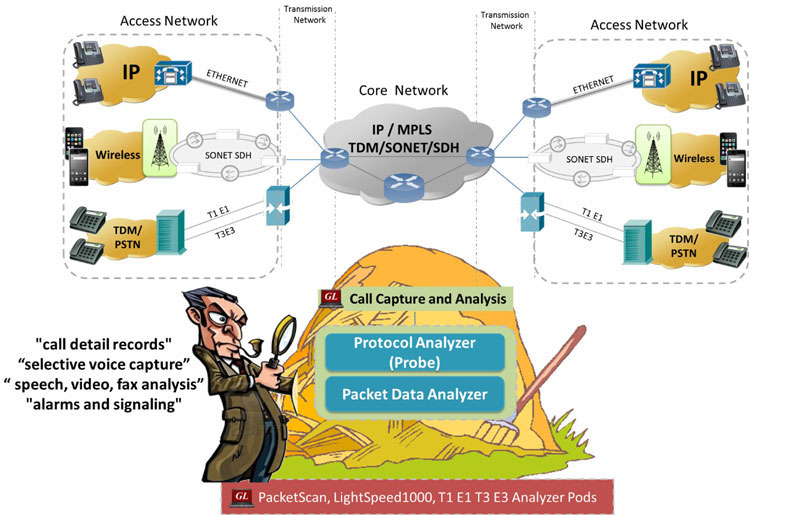Massive Call Capture, Analysis, Monitoring of
Wireless, IP, Optical, TDM and PSTN Networks
30th, Mar 2018
Welcome to another March 2018 issue of GL's Newsletter providing information and insight into our latest software solution for Lawful Interception, Data Retention, Fraud Detection, and Voice Quality and more.

Introduction
Various methods are deployed by network operators to study the existing usage patterns, detect sudden changes in usage patterns and identify fraudulent behavior. When "problem calls" occur infrequently but often enough, they can negatively affect profit, productivity and efficiency.
However, to analyze "why or how such a problem occurred" when massive call volumes are involved, operators are presented with the difficulty of finding a needle in a haystack.
Generally, methods deployed to perform fraud detection, is to use monitoring tools non-intrusively. Lawful interception systems for IP and TDM may be used or conventional tools to capture unknown or abnormal calls based on the calling activity. Capture, monitoring, and filtering tools can help to identify and to drill-down the “calls-of-interest” or “fraudulent calls”.
Software Solution
As depicted in the main diagram above, Protocol Analyzers (Probes) and Packet Data Analyzers (PDAs) which provide CDR Analysis are the core components of GL’s Signaling and Traffic Analysistest suite.
Protocol Analysis probes are deployed in the network to non-intrusively monitor and capture the bi-directional calls on the network. These probes are available for all networks – IP, Wireless, Optical, TDM, and PSTN, and depending on the underlying network, suitable Analyzer platform may be used.
PDAs work with probes to generate CDRs, record voice/video/fax/tones/digits on the established calls and perform analysis on captured data quality. PDA processes the captured packets/frames, identifies, and segregates calls based on signaling and traffic parameters. Sophisticated filters permit zooming and recording of specific calls of interest. All or filtered traffic can be recorded into a trace file.
Users can listen or record audio and data of a VoIP session calls in real-time. And can also perform speech-level analysis, fax analysis, video analysis, power, frequency, spectral, tone and digit analysis with ease and precision. The process helps users to get an exact picture of Quality of Service (QOS) and the technical adherence of the system under test (adherence to the protocols specified by the standardizing authority).
Signaling and Traffic Analysis software and hardware have been widely used by network operators and carriers to troubleshoot poor call quality problems, or as modules or tools in “larger lawful intercept” solutions, to detect fraudulent calls, for traffic engineering, for call analysis, and for billing. These tools can detect, classify and selectively capture “calls-of-interest” from massive volume of calls.
Important Features
- Scalable architecture allows up to STM-4 rate per server and multiple servers can be stacked to increase call capturing capacity to 10's of thousands of calls
- Signaling decode information on each call, including ladder diagrams
- Detect call types (voice, sms, fax, video, …)
- Store CDRs in database/ CSV file formats
- Automatically record voice traffic for all calls or filtered calls
- Continuous unlimited recording, limited only by hard disk or network storage space
- Capture/playback audio – listen and record audio streams
- Ability to store voice in PCM or WAV formats
- Drill-down to problem calls using filters for post analysis
- Analyze and identify customer calling patterns
- Capture for extended periods of time from hours to months
- Search for "calls of interest" while live capturing continues
- Filter calls based on called number, calling number, or type of call
- Monitor daily operations thru call statistics
- Monitor usage of trunks on a daily or weekly basis
- Provide insight into overall performance
Supported Protocols
Supported protocols include SIP, SIGTRAN, ED137, RTP, MEGACO, MGCP, Skinny (SCCP), LTE, IMS, Diameter, UMTS, GSM, CAP, MAP, INAP, SS7, ISDN, PPP, and CAS.
Applications
Post Call Analysis for Call Quality, Called / Calling Numbers, Mid Call Digits
- Capture continuously 24/7
- Drill-down to problem calls for post capture for analysis
- Filter records between certain time duration, MOS score, codec, called number, calling number, or calls with certain mid call digits
Calls of Interest, Fax Calls, SMS Calls, Selective Calls
- Search for "calls of interest" while live capturing continues
- Identify different call types (Voice, SMS, Fax, Location update, Supplementary Services, …)
- Filter and drill down to certain voice calls (incoming, outgoing, advertising)
- Record calls from un-identifiable source or unusual customer
- Identify and troubleshoot fraudulent calls
Traffic Engineering
- Historical storage and retrieval of call capture records
- Find calls by 'days of the week' Or by 'hour of the day' (24-hr period call analysis)
- Analyze the total and average call duration per hour, per week, or month
- Analyze and identify normal and unusual calling patterns
- Monitor daily operations through call statistics
- Monitor usage of trunks on a daily or weekly basis
Voice Quality
- Generate automated Call Quality Reports periodically and send email
- Identify factors that voice quality and network performance – by statistics and graphs
- Call Volume and Duration over day, week, or month
- Call failure causes, answered or unanswered calls
- Session disconnect delay, post dial delay
- MOS scores - conversational and listening
- Average packet loss, jitter, and delay
 Back to Newsletter Index Page
Back to Newsletter Index Page